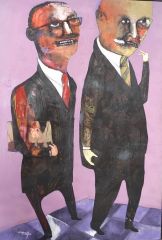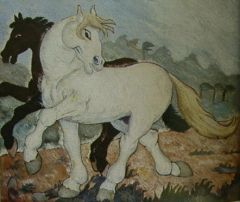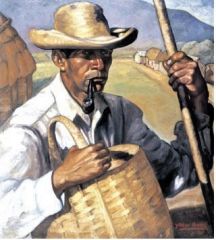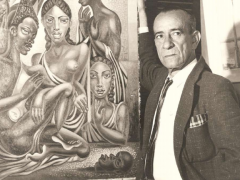![]()
![]()
![]()
Use LEFT and RIGHT arrow keys to navigate between flashcards;
Use UP and DOWN arrow keys to flip the card;
H to show hint;
A reads text to speech;
6 Cards in this Set
- Front
- Back

Ney Diaz |
Ney Diaz - Rising Star in Contemporary LatinAmerican Art! This is a superbmixed media work on paper by the controversial Dominican artist NeyDiaz, who has become a favorite of internationalart collectors. Diaz is known for his brash personality and powerful,raw paintings. His works display an imagination and acompelling style that has an undeniable impact .This mixed mediawork on paper is wonderful. |
|

DarioSuro |
Darío Antonio Suro García-Godoy (La Vega, 13 de junio de 1917 – Santo Domingo, 18 de enero de 1997) fue un pintor, crítico y diplomático de República Dominicana. Fue sobrino del pintor Enrique García Godoy, su primer profesor de arte. Junto a Yoryi Morel y Jaime Colson, es considerado uno de los fundadores de la escuela de modernismo en la pintura dominicana.1 2 3Nacido en una familia con vocación por las artes y la política, Darío Suro fue pariente de eminentes dominicanos. Fue nieto del novelista Federico García Godoy y bisnieto del poeta y educador Federico García Copley, también fue sobrino del pintor y escultor Enrique García-Godoy Ceara (abuelo del caricaturista Harold Priego García-Godoy) y de la diputada Rosa Delia García-Godoy Ceara, quien llegó a ser gobernadora de La Vega. Además era primo del presidente Héctor García-Godoy Cáceres, y tío abuelo segundo de la actriz Laura García-Godoy Oliva.4Entre 1946 y 1948 se trasladó a México estudiando con los maestros del muralismo Diego Rivera, Agustín Lazo y Jesús Guerrero Galván. Sus temas de aquella época componen una interesante mezcla de las preocupaciones sociales y raciales de su país con el estilo muralista mexicano; tiene la fuerza expresiva dramáticamente social y con especial énfasis racial. Los trabajos de este período son los que más repercusión lograron en la posterior producción dominicana.Al regresar de México, la Galería de Bellas Artes de Santo Domingo realizó la primera exposición monográfica del artista, la cual obtuvo gran aceptación y favorable crítica. La pintura de esta época muestra un nacionalismo bien inspirado y profundo, exento de puerilidades y de la pura copia de una temática localista.A sus años en Madrid, donde se desempeñó como agregado cultural, corresponden una serie de obras que, aunque son la continuación de sus lineamientos figurativos desarrollados hasta entonces, constituyen un cambio formal y temático de expresión. Ese cambio refleja la conjugación no pretenciosa de lo primitivo con lo expresionista, desde un ángulo socializante exento de todo su subjetivismo. Otro cambio en la pintura de Suro es su penetración en lo abstracto, en la que «no hay que ver una actitud revolucionaria, sino una reacción contra el intelectualismo de su pintura precedente».Además de pintor, Dario Suro fue crítico de arte y diplomático. Expuso en colectivas internacionales y nacionales muy importantes. Realizó exposiciones individuales en Londres, París, Madrid, Italia, Colombia, Alemania y Estados Unidos de América, especialmente en el Riverside Museum de Glasgow, la galería de Rose Eried y en la Poindexter de Nueva York, las cuales han tenido merecidamente la acogida del público y de la crítica. Concurrió a numerosas bienales incluyendo la de Venecia, y la de Pittsburg, así como a las de Santo Domingo, obteniendo en todas premios y reconocimientos.5 |
|

Yoryi Morel |
Yoryi Morel (born Jorge Octavio Morel Tavares) (1906–1979) was a painter from the Dominican Republic. Along withJaime Colson and Darío Suro, he is considered one of the founders of the modernist school of Dominican painting.A native of Santiago de los Caballeros, he spent most of his career in Santiago Province. Although he studied underJuan Bautista Gómez in his youth, he is generally considered to be self-taught. Morel is the leading Dominicancostumbrista painter and is known for his landscapes, genre paintings, and portraits.Morel held his first solo exhibition in Santo Domingo in 1932. He participated in the Dominican Republic's first biennial art exhibition in 1942, and won first prize in the sixth biennial in 1952. He was declared the "Pintor Nacional" (national painter) by the Dominican Congress on October 25, 2006. |
|

Jaime Colson |
"Jaime Colson was born in the city of Puerto Plata, Dominican Republic in 1901 and died in Santo Domingo in 1975. Colon studied painting at the Academy of San Fernando in Madrid. He also studied in Barcelona where he deepened the drawing skills with the Catalan masters of the century. He lived in Paris in the 1920s where his painting took a turn sharply humanist turn. Under the influence of Picasso, Braque and Leger, he accomplished works with cubist architectural influence and adherence to the geometric.Colson traveled to Mexico, where he lived from 1934-1938. He taught at the Art School for Workers and ventured into mural studies with an emphasis on social issues and worked and befriended Siqueiros, Orozco and Diego Rivera. Colon had several successful exhibitions in which he introduced a free version of neo-humanist cubism.In 1938 traveled to Havana, Cuba, where he produced several exhibitions, both collective and individual. He was professor of Mario Carreno and other renowned Cuban painters. In the works he made during that time, one can see a remarkable symbiosis between architecture, neoclassicism and metaphysics. In that same year he returned to Paris where he did excellent work with neohumanist trend. This period coincides with his return to Santo Domingo in 1950, where he was appointed Director General of Fine Arts, a position he held until 1951, without adapting to the administrative functions.Back in his homeland, Colson dedicated his time to spread his knowledge and skills, being able to transmit to his students, his personal style, safely and refined.Dejected by physical ailments and emotional losses, he took temporary refuge in the province, concentrating harder on his works. He then traveled to Haiti and Caracas, Venezuela. Finally returning back to Santo Domingo where he died after a long illness.Jaime Colson, passionate and rebellious artist whose life was a continuous path from country to country, experimented with many artistic movements, especially Cubism, surrealism, neo-classicism, and a period of mystical religious influence, to which he integrated a strong Creole influence. His pictorial work, described as figurative and neo-humanist inspiration, pays tribute to the human body in all its forms."-- The text above is a translation of an article by The Museo Bellapart, a private art museum in Santo Domingo, Dominican Republic. Its collection includes artwork from the mid-19th century to the 1960s. |
|
|
Toni Capellan |
Grabadista. Nació en Tamboril en 1985. Estudio Artes Publicitarias en la Universidad Autónoma de Santo Domingo (UASD). Ha obtenido premios y menciones en importantes concursos de carteles y grabados. Trabaja en la actualidad la técnica de la xilografía. Participo en la VI Bienal de Grabado Latinoamericano con el tema ``Acerca de las cosas irremediablemente perdidas'' y la XVII Bienal de Artes Visuales 1990 |
|
|
Abelardo Rodriguez Urdaneta |
Abelardo Rodríguez Urdaneta (born in Santo Domingo, Dominican Republic 1870–1933) was a Dominican sculptor, photographer, painter and educator. He is considered to be one of the founders of modern Dominican sculpture.[1][2] Urdaneta studied painting and sculpture in the workshop of Juan Fernández Corridor and Cruz, a Spanish painter, who opened an academy in the city of Santo Domingo from 1883 to 1886. Later he attended the workshop of Dominican painter Luis Desangles Lubiles (Sisito). He was also an apprentice of Photography in the studios of July Pou and shared photographic and sculptural techniques with Spanish photographer and sculptor Frank ADROVER Mercadal. He also received guidance from Cordiglia, who came to Santo Domingo in 1884 from Venezuela.Career[edit]In 1898 his photo of Arthur B. Pellerano Alfau was published, considered to be the first photograph published in a Dominican magazine. Since 1901 he worked in his photographic studio and cultural center in the city of Santo Domingo, visited by personalities from politicians and artists including José Martí and Hostos.In 1903 he conducted the historic and celebrated sculpture "One of many" a wounded soldier, left on the ground, with torn clothes and bare chest, one of the works for which he obtained the most recognition in the Republic and the world. In 2009 this sculpture was removed due to remodeling the current Galicia Park. According to information received from the families of local authorities, the work was restored but would be relocated elsewhere.In 1908 with support from the Central Government he opened an academy of drawing, painting and sculpture that helped to train many young people of the time. His engravings reproduced notable visitors, ruins, palaces, gates, colonial facades, bankers, intellectuals and teachers.His creative work was composed of a large number of portraits, busts, statues, monuments and reliefs in which he collected important moments in Dominican history that reflected the life of governors, patricians, merchants, community leaders and families of the time. His school remained active until 1933, the year of his death.Politics[edit]He was a vocal opponent of the First American Intervention. His "Invocación" poster in which the Dominican Republic is represented as a female figure with arms raised and hands held by the claws of an eagle, became widely circulated throughout the country. |

